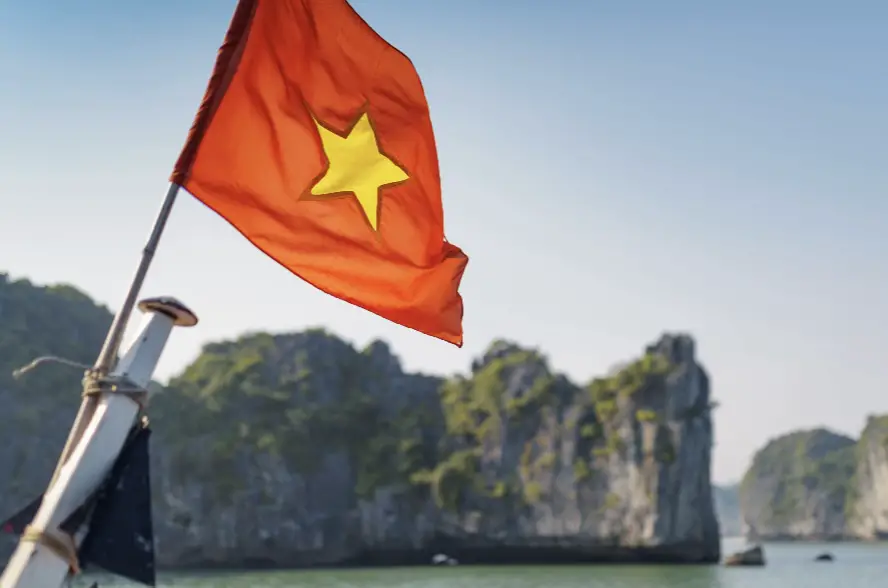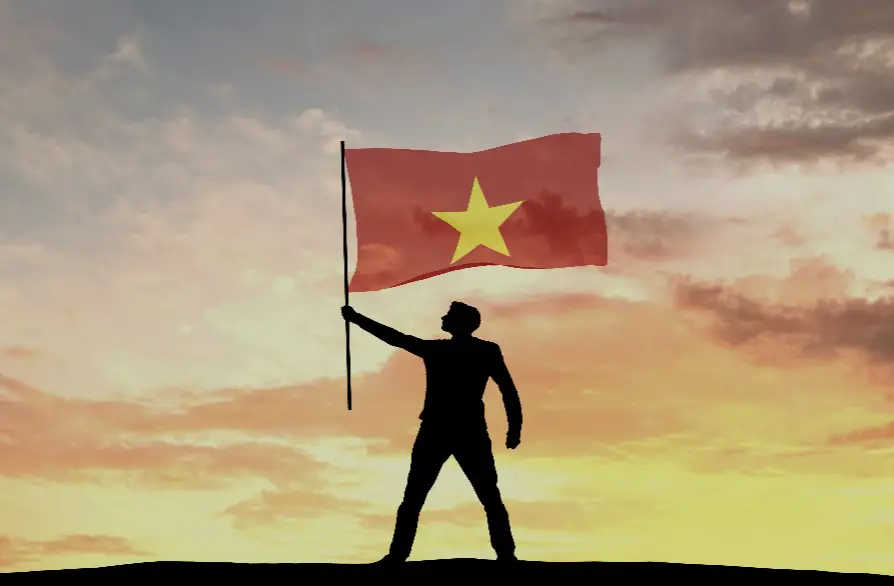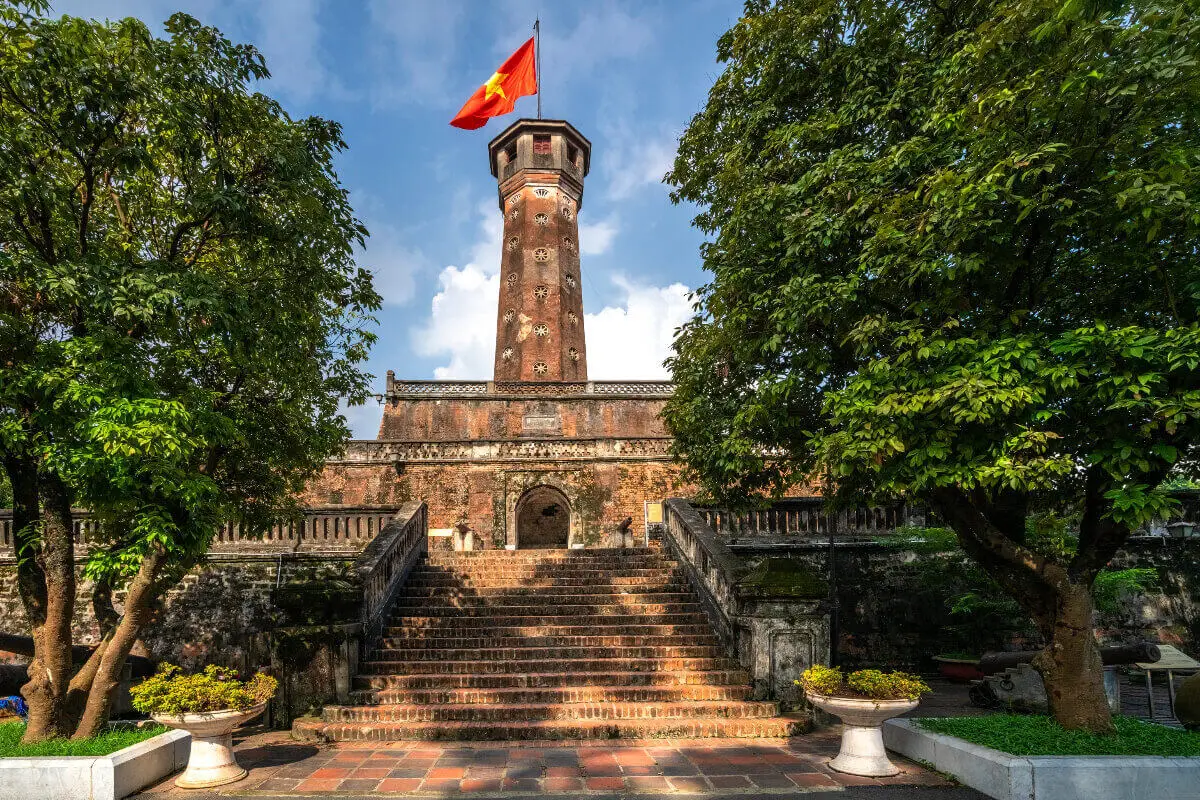Stitched into the fabric of Vietnam’s vibrant cultural tapestry is an iconic symbol that evokes a rich historical narrative, symbolizing unity, independence, and strength: the North Vietnamese flag. As an integral part of Vietnam’s national identity, it powerfully encapsulates the trials and triumphs of the Vietnamese people. From its inception, the North Vietnamese flag is a testament to the nation’s resistance and drive toward unity.
The flag’s arresting design — a lone golden star set against a mesmerizing field of red — tells the story of a people’s struggle for liberty and aspirations for prosperity, injecting a profound sense of pride and patriotism permeating every fascinating aspect of its being. This essay explores the North Vietnamese flag, from its historical origins to its powerful symbolism and enduring role in contemporary Vietnam.
Table of Contents
- The Origins of the North Vietnamese Flag
- The Symbolism of the North Vietnamese Flag
- The North Vietnamese Flag Today
- Interesting Facts about the North Vietnamese Flag
- Related Questions
The Origins of the North Vietnamese Flag
An adventure awaits you in every nook and cranny of the world, friends! Don’t you love it when you can weave an exciting journey with the rich tapestry of history? Today’s journey takes us to the mesmerizing landscape of North Vietnam and the history behind its flag.
Charming folks with its simplicity yet uniqueness, the flag of North Vietnam has a fascinating tale to narrate, a tale of revolution and courage. Sporting a sizeable golden star at the center of a bright red background, it’s a symbol that has changed little over the years.
The golden star, representing the five main classes of people in Vietnam – intellectuals, farmers, workers, business people, and military personnel – stands as a testament to the unity of the Vietnamese people.
It’s a beautiful symbol that portrays Vietnamese society’s collective spirit and diversity. Isn’t it wonderful how flags can reveal a nation’s identity?
Now, let that travel bug carry you to the late 1940s. This was a time when Vietnam was in the clutches of a brutal war for its independence from France, known as the First Indochina War. In these turbulent times emerged a leader who would become synonymous with Vietnam’s struggle for sovereignty – Ho Chi Minh.
In 1945, the Vietnam Revolutionary League, under Ho Chi Minh’s leadership, took control over Hanoi after a coup and formed the Democratic Republic of Vietnam, commonly referred to as North Vietnam. With this victory, a new flag was raised, a symbol of hope, unity, and freedom – yes, you guessed it right, our vibrant red flag with its golden star.
Though unofficial then, it was during this era that the flag evolved into an icon of resistance for the Vietnamese people. The flag officially fluttered as the national flag of North Vietnam in 1955 and represented the country until it was united with South Vietnam in 1976.
Today, standing proud on flagpoles and printed on travel souvenirs throughout Vietnam, it continues to tell the tale of a nation that fought with tenacity for its place in the world. The flag evokes a sense of courage, unity, and freedom that can’t help but charm and inspire every traveler to explore further and deeper into this enchanting land!
So, the next time the wanderlust calls for a whirlwind Vietnamese adventure, pause to marvel at this simple yet powerful embodiment of the country’s historical roots. Happy exploring, fellow nomads!

The Symbolism of the North Vietnamese Flag
Wear an adventurous spirit on your sleeve as we dive a little deeper into the captivating design and symbolism of the North Vietnamese flag. Trust me, beneath the red field and the golden star lies a tale of courage, resilience, and the indomitable spirit of freedom. So, if you’re up for it, let’s unravel more about this iconic symbol through the lens of a seasoned traveler and gypsy-hearted nomad.
There’s a palpable zest and spirit within the vibrant red backdrop of the flag, one that’s a testament to Vietnam’s fiery pursuit of freedom and sovereignty. This striking imagery isn’t simply an aesthetic choice but the lifeblood of someone who has stood gallantly in adversity.
While the fiery red backdrop of the flag undeniably catches the eye, the golden star at its heart carries its profound symbolism. Representative of Hannah Arendt’s famed line, “Every revolutionary ends by becoming either an oppressor or a hermit,” the lone star is a physical manifestation of the ideals of socialism and the five main social classes in Vietnam – intelligentsia, farmers, workers, businessmen, and military personnel, all united as one by a radiant star on a stalwart hunt for freedom!
A tribute to the wondrous design of the flag would be incomplete without acknowledging the inspirational role of Ho Chi Minh in its inception. As the revolutionary leader who ostensibly penned down Vietnam’s Declaration of Independence, he was instrumental in rallying the Democratic Republic of Vietnam around the vibrant flag. This courageous spirit is mirrored in the resilient fabric of the flag, an emblem etched into the heart and soul of Vietnam.
What’s fascinating is how the flag has evolved from a symbol of defiance to an enduring beacon of national unity, from encapsulating the enthusiasm of the First Indochina War to representing the struggle for independence. Its star-studded history makes it a remarkable symbol in the ever-evolving Vietnam.
The flag is no mere cloth to the modern Vietnamese but an esteemed symbol of courage, unity, and freedom. Each flutter reminds them of their roots, informs their present, and inspires their future. It’s inextricably linked with their national identity and breathes a spirit of resilience into the nation’s soul.
Are you planning a heart-throbbing escapade to Vietnam? Go beyond the scenic splendor, tantalizing cuisine, and vibrant city life. Revel in the flag’s deep-rooted historical tower, and let its story resonate with your soul. More than just a flag, it’s a canvas aglow with tales of survival, endurance, revolution, and resolve. A spectacle to behold, it will make your Vietnamese tour worthwhile!
So, on your next wanderlust-triggered journey to Vietnam, embark on an adventure and a meaningful appreciation of its rich history. By understanding the Vietnamese flag’s inherent symbolism, you will not just visit a foreign land but genuinely explore it. Consider this an open invitation to make Vietnam your next favorite travel destination.
Prepare to unlock a treasure trove of cultural riches as you make the flag a cornerstone of your exploration because nothing allows you to truly appreciate a country like understanding its national symbols. The Vietnamese flag is a radiant expression of its national soul. So, are you ready to book your ticket to this majestic land and start your adventure?

The North Vietnamese Flag Today
As we journey deeper into the symbolism behind the North Vietnamese flag, its considerable presence in Vietnamese society today becomes even more evident.
Apart from being an emblem of the country’s years of resistance, struggle for freedom, and its birth as an independent nation, it continues to be a potent symbol in the hearts of the Vietnamese people. It’s not simply about the past—it’s a living embodiment of Vietnamese nationalism, resilience, and aspiration that is worth understanding if you aim to delve into the characteristic charm of the Land of Blue Dragons.
Swing by the bustling streets of Hanoi or take a tranquil boat ride on Ha Long Bay, and you’ll notice the North Vietnamese flag fluttering with a sense of pride and memory. Adorning official buildings, schools, and homes is a vivid reminder of the hard-fought battles, collective resilience, and the nation’s commitment to unity and socialism.
Look beyond the stars and stripes, and you’ll find that it transcends daily life, giving a testimony to the enduring local folklore and traditions. Much like a north star to a sailor, the golden star in the flag acts as a beacon of direction, reinforcing Vietnamese societal values. Age-old traditions remain relevant, and the flag finds its place in ceremonial celebrations and festive occasions, illuminating the spirit of unity and communal harmony.
But let’s not forget that the Vietnamese flag is a crucial element in one significant event every year, the National Day of Vietnam. On September 2nd, throughout this country, the flag saturates every nook and corner, from the bustling city to serene villages; during this time, the flag embodies a renewed meaning—a celebration of freedom, a reflection of the victorious past, and above all, an embodiment of national pride.
Understanding the deep connection between the North Vietnamese flag and the psyche provides a deeper appreciation of Vietnamese culture. And isn’t it quintessential, as an avid globetrotter, to unruffle layers of a land’s symbol, conjuring a deeper connection to its history, people, and essence?
Get lost in the beauty of the lush green rice terraces in Sapa, be awed by the ancient architecture in Hoi An, or explore the labyrinthine markets in Saigon. At the same time, the ‘red flag with a gold star’ whispers tales of resilience, unity, and freedom—adding resonance to your Vietnamese voyage.
And so, as you step into the enchanting landscapes of Vietnam, take a moment to appreciate the ubiquitous fluttering flag—not just as an official national symbol, but as a charming storyteller, a steadfast symbol of the nation’s fighting spirit and, above all, the heart of Vietnam. Infuse your journeys with this understanding, and as the Vietnamese proverb goes, “A day of traveling will bring a basketful of learning.”

Interesting Facts about the North Vietnamese Flag
Now that we’ve unpacked the lofty symbolism and historical significance of the Northern Vietnamese flag let’s take a sneak peek into some delightful trivia – those unique, lesser-known anecdotes that add a dash of zing to our travel narratives.
Like those hidden alleyways and remarkable local eateries you stumble upon on your meanderings, these tidbits of knowledge bring a smile to your face and deepen your understanding of Vietnamese culture.
Did you know that the flag — with its vibrant stark red backdrop and the gleaming yellow-gold star — is fondly referred to as “cờ đỏ sao vàng”? In Vietnamese vernacular, it translates to “red flag with a gold star.” Such an endearing nickname embraces the simplicity of everyday local language while cherishing the profound ideology enveloped in this national emblem.
The golden star at the center of the flag represents the unity of five main classes in Vietnamese society — intellectuals, farmers, workers, business people, and military personnel, which makes it apt to say that the North Vietnamese flag, in its reverberating crimson shade and the symbolic golden star, whispers tales of unity in diversity.
Consider the image of a little child dashing across the street, a miniature replica of the North Vietnamese flag sailing joyously in their hand. This is a common sight during the Vietnamese Tet or the New Year celebrations. The flag becomes integral to their festivities, skillfully woven into parades and traditional folk games, infusing an enchanting patriotic spirit into these celebrations.
You are moving on to northern Vietnam’s stunning coastlines. As you sail across the emerald waters of Ha Long Bay, shrouded in mystery and dotted with thousands of limestone islands, you’ll often notice the echo of the flag’s vibrant red fluttering on the boats, working harmoniously with the scenic landscape, mimicking the passionate pulse of Vietnam.
Venture into the heart of Hanoi to the Ho Chi Minh Mausoleum – and you’ll see our iconic flag proudly flying amidst a collective sigh of respect and remembrance. As a traveler, you can’t help but catch your breath at this profound, silent display of reverence for their history.
The country’s National Day, September 2nd, offers an awe-inspiring sight when the fluttering flags accentuate the vibrant energy of Vietnam. The day commemorates the Declaration of Independence from France and the formation of the Democratic Republic of Vietnam in 1945, and the North Vietnamese flag represents the embodiment of the nation’s resolution for freedom.
Finally, an interesting nugget for your palette – a tantalizing local dish, the flag rice (com ky la) is presented with toppings of vegetables and meats, symbolizing the colors of the Vietnamese flag. You got it! It is expected to witness the flag’s influence stretching tastefully onto the dinner plates, appealing to the eyes and the palette.
So, fellow nomads, as you trace the enchanting lanes of Vietnam, watch out for the fluttering red and yellow. Each glimpse of the North Vietnamese flag is a burst of stories – stories of resilience, solidarity, and freedom.
It connects you to Vietnam’s pulse, a constant reminder of their past struggles and their vibrant, forward-looking spirit. It’s not just a flag; it’s the heart of Vietnam, beating in unison with the country and its people. Safe travels, explorers!

Thoroughly woven into Vietnam’s tapestry of history, the flag’s powerful visuals provide an unmistakable glimpse into the nation’s journey and principles. Its golden star shining on a backdrop of red serves not as a mere decoration but as a potent reminder of the country’s revolutionary spirit, resilience, and unity.
In the heart of every Vietnamese, the flag asserts itself as a proud emblem of a united and independent nation.
Even beyond Vietnam, it commands respect and recognition, is prominent in media and international events, and is ingrained in the consciousness of those who appreciate the triumph of the human spirit against adversity.
Hence, with its fascinating tales, profound symbolism, and ongoing relevance, the North Vietnamese flag continues to reverberate as a tale of the nation, waving high in the winds of the present and the unchartered future that awaits the Vietnamese people.
At A Bus On A Dusty Road, we talk about everything about travel, life, and ex-pat living. We are all about “Living Life As A Global Citizen.” We explore social, cultural, and economic issues and travel.
We would love to have you be part of our community. Sign up for our newsletter to keep up-to-date by clicking here. If you have any questions, you can contact me, Anita, by clicking here.
Listen to our Podcast called Dusty Roads. You can find it on all major podcast platforms. Try out listening to one of our podcasts by clicking here.
Subscribe to our A Bus On A Dusty Road YouTube Channel with great videos and information by clicking here.
Related Questions
How Similar Are The Chinese And Vietnamese Languages?
Vietnamese and Chinese are Asian languages though they come from different language families. Vietnamese and Chinese are both tonal languages and have similar sentence structures. They are monosyllabic languages, meaning that one word has one syllable, and several dialects are spoken.
By clicking here, you can discover How Similar Are The Chinese And Vietnamese Languages?
What Is The Official Language Of Hong Kong?
The official language of Hong Kong is Chinese and English. The residents of Hong Kong are native Cantonese Chinese speakers, so the official language is Cantonese Chinese. Many in Hong Kong can also speak Mandarin Chinese; many local Hong Kong residents prefer to speak Cantonese Chinese or English.
By clicking here, you can discover What Is The Official Language Of Hong Kong?
Vietnam Or Thailand, Which Country Is Better For Living?
Deciding between living in Vietnam or Thailand can be a difficult choice, as both countries offer unique opportunities for ex-pats and locals alike. With dynamic cultural influences, an exciting nightlife scene, and stunning natural attractions, it can be hard to decide which country is ultimately better. Read on to help you make a decision as to which place you should consider.
By clicking here, you can discover Vietnam Or Thailand, Which Country Is Better For Living?

